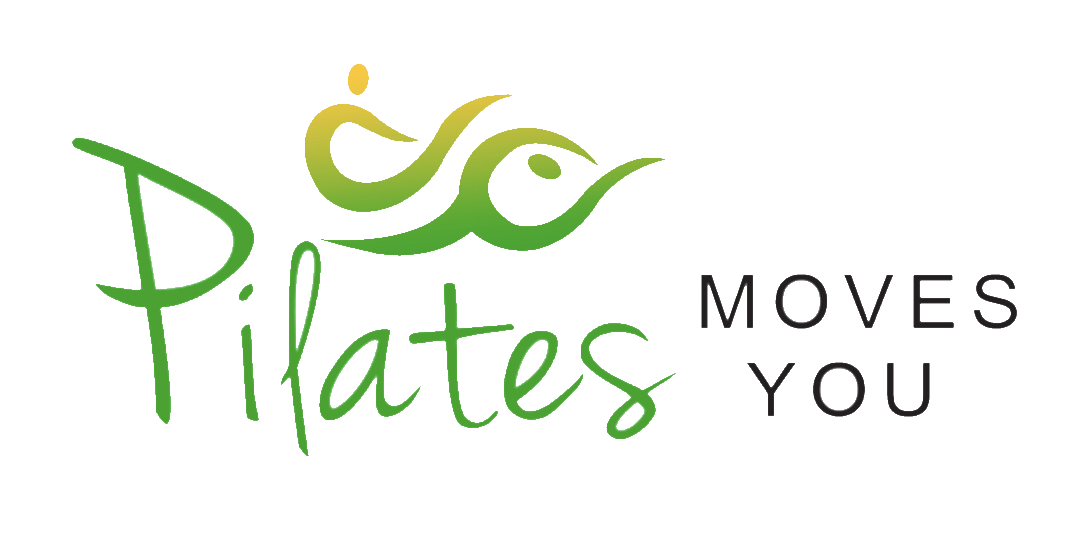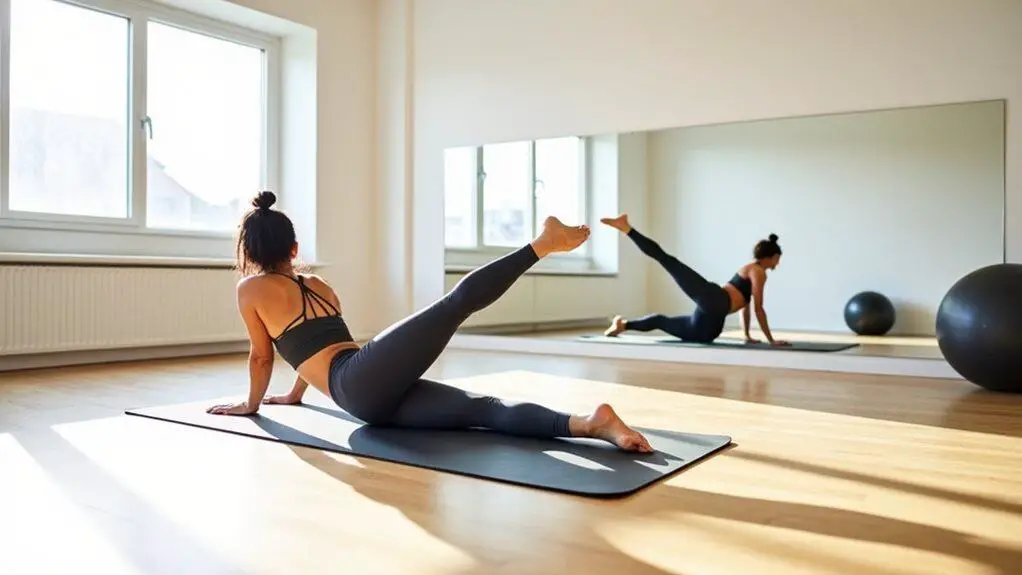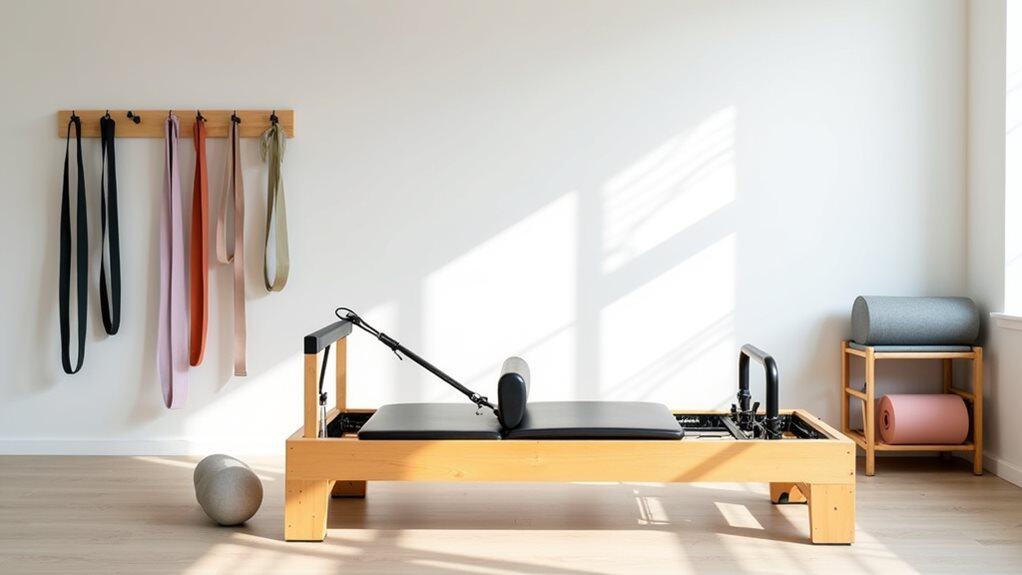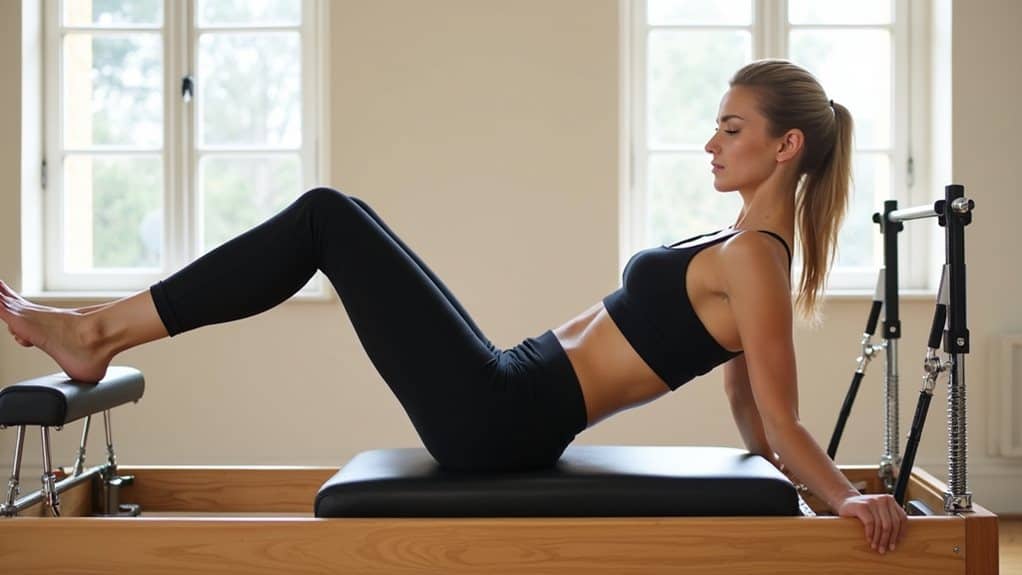Are you tired of battling back pain? Do you dream of having a strong, stable core that supports your daily activities with ease? Look no further than the power of Pilates!
As a team, we have discovered the incredible benefits of Pilates for building a rock-solid core and banishing back pain. Not only has this practice helped us improve our physical strength and flexibility, but it has also empowered us to maintain a healthy, pain-free lifestyle.
In this article, we will guide you through the basic principles of Pilates and provide you with a variety of exercises to strengthen your core, relieve back pain, and increase your flexibility. Whether you are new to Pilates or a seasoned practitioner, this article will help you harness the power of Pilates to achieve unmatched strength and freedom from pain.
So, let’s get started on the journey to a rock-solid core and a healthier, happier you!
Key Takeaways
- Pilates can help build a strong, stable core and improve posture and balance.
- It targets the deep muscles of the core and breathing and alignment are essential for proper form.
- Pilates can benefit athletes by improving performance and aiding in recovery, as well as preventing injuries and reducing the risk of chronic back pain.
- To practice Pilates, it’s important to work with an experienced instructor for proper form and wear form-fitting clothing for proper alignment.
Understanding the Importance of Core Strength
You can’t ignore the importance of having a strong core, it’s the foundation for a pain-free back and a more powerful you! The benefits of core strength go beyond just aesthetics, as it plays a crucial role in maintaining good posture and balance.
A strong core helps to support the spine, reducing the risk of back pain and injury. Core strengthening techniques are not limited to just crunches and sit-ups. In fact, Pilates is a highly effective way to build a rock-solid core.
Pilates focuses on working the deep muscles of the core, including the transverse abdominis, pelvic floor, and obliques. By strengthening these muscles, you’ll improve your overall stability and balance. Incorporating Pilates into your fitness routine is a great way to start building a strong core.
Don’t be intimidated by the equipment or the seemingly complex movements, Pilates is accessible to all fitness levels. With consistent practice, you’ll start to notice the positive changes in your core strength and overall physical performance. So let’s dive into the world of Pilates and discover the power of a strong core!
Getting Started with Pilates
Starting Pilates can be an excellent way to improve your overall fitness and flexibility. This low-impact exercise routine focuses on controlled movements that target your core muscles, helping you build strength and stability. If you’re interested in trying Pilates, here are some tips to get started:
- Look for a qualified instructor: Pilates requires precise movements and proper form, so it’s important to work with an experienced instructor who can guide you through the exercises. Ask for recommendations from friends or search for certified Pilates instructors online.
- Find a studio or gym with Pilates equipment: While you can do some Pilates exercises on a mat, many moves require specialized equipment, such as a reformer or a Cadillac. Look for a studio or gym that has the equipment you need to get the most out of your Pilates practice.
- Wear comfortable, form-fitting clothing: You don’t need any special gear to do Pilates, but wearing loose or baggy clothing can make it difficult to see your body’s alignment and movement. Opt for form-fitting clothes that allow you to move freely and comfortably.
- Start with beginner classes: Pilates can be challenging, so it’s important to start with a beginner class if you’re new to the practice. As you build strength and confidence, you can move on to more advanced classes.
With these tips in mind, you can start your Pilates journey with confidence. In the next section, we’ll explore the basic principles of Pilates and how they can help you build a rock-solid core and banish back pain. Let’s dive in!
The Basic Principles of Pilates
Learning the basic principles of Pilates is essential for achieving proper form and maximizing the benefits of this low-impact exercise routine. Two of the most important principles are Pilates breathing and Pilates alignment.
Pilates breathing involves inhaling through the nose and exhaling through the mouth while engaging the core muscles. This technique helps to increase oxygen flow to the muscles and promote relaxation.
Pilates alignment refers to the proper positioning of the body during each exercise. It involves maintaining a neutral spine, a stable pelvis, and proper shoulder and hip alignment. A good way to check your alignment is to stand with your back against a wall. Your head, shoulders, and hips should all be touching the wall, with a slight curve in your lower back. This alignment helps to ensure that the right muscles are being targeted during each exercise.
Mastering these basic principles will set a strong foundation for your Pilates practice. As you incorporate these principles into your routine, you’ll begin to see improvements in your posture, flexibility, and core strength.
In the next section, we’ll explore some Pilates exercises specifically designed to target and strengthen your core. By incorporating these exercises into your routine, you can build a rock-solid core and banish back pain for good.
Pilates Exercises for Core Strength
Engaging in Pilates exercises specifically designed to target and strengthen the core can result in a more toned midsection and improved posture, as well as increased flexibility and stability throughout the body. Pilates equipment such as the reformer, Cadillac, and chair can add resistance and challenge to core exercises, allowing for even greater strength gains.
Advanced movements like the teaser, plank variations, and the hundred can take your core strength to the next level. When performing Pilates exercises for core strength, it’s important to maintain proper form and engage the deep abdominal muscles. This means avoiding overarching the lower back or relying on the hip flexors to do the work.
With consistent practice, Pilates can help you develop a strong, stable core that supports all your movements and activities, from lifting weights to running to everyday tasks like carrying groceries. If you’re looking to banish back pain and improve your overall core strength, Pilates is a great place to start.
In the next section, we’ll explore how Pilates exercises can specifically target the muscles of the back to help alleviate pain and tension. By incorporating these exercises into your routine, you can achieve a stronger, more functional body and enjoy the freedom to move with ease and confidence.
Pilates Exercises for Back Pain
Let’s dive into some Pilates exercises that can help alleviate back pain. The Spine Stretch, Swan, and Shoulder Bridge are great exercises to target the muscles in your back and strengthen your core at the same time.
These exercises can improve your posture, reduce tension in your back, and increase your overall flexibility. Let’s give them a try and see the benefits firsthand.
Spine Stretch
Get ready to feel the stretch in your spine with this Pilates move! The Spine Stretch is one of the most effective stretching techniques to alleviate back pain. With proper form, this exercise can help lengthen your spine, improve posture, and increase flexibility.
Here are a few things to keep in mind while performing the Spine Stretch:
- Sit up tall with your legs straight and shoulder-width apart.
- Inhale and raise your arms above your head.
- Exhale as you slowly reach forward, keeping your arms parallel to the ground and your back flat.
As you repeat this exercise, you’ll feel your spine stretch and your muscles loosen up. Don’t be afraid to push yourself a little further each time, but always remember to maintain proper form to avoid injury. With consistent practice, you’ll notice a significant improvement in your core strength and back pain relief.
Now, let’s move on to the next exercise – the Swan. This move is a great way to build even more strength in your core and back muscles.
Swan
After the Spine Stretch exercise, it’s time to move on to the Swan. This exercise is a great way to strengthen your back muscles and improve your posture.
The Swan is a Pilates classic that has many variations to challenge your body and help you achieve a rock-solid core. The benefits of the Swan exercise are numerous.
It strengthens your back muscles, improves your posture, and increases flexibility in your spine. There are many Swan variations, such as the Swan Dive, the Swan on the Roller, and the Swan with Arms Extended.
Each variation targets different muscles and challenges your body in a unique way. By incorporating the Swan exercise into your Pilates routine, you’ll not only strengthen your core but also improve your overall physical health and well-being.
Moving forward, let’s talk about the Shoulder Bridge exercise.
Shoulder Bridge
The Shoulder Bridge exercise involves lifting your hips off the ground, creating a bridge-like shape with your body. This is a great exercise to improve hip mobility and activate your glutes. Here are 4 important things to keep in mind while performing this exercise:
- Keep your feet parallel and hip-width apart.
- Engage your core muscles to protect your lower back.
- Squeeze your glutes as you lift your hips up towards the ceiling.
- Lower your hips down slowly and with control, using your glutes and hamstrings to maintain the bridge position.
By incorporating the Shoulder Bridge exercise into your Pilates routine, you can develop a strong and stable core while also improving your hip mobility and glute strength. This will help you banish back pain and improve your overall physical performance.
In the next section, we’ll discuss Pilates exercises for flexibility that’ll complement the strength-building exercises we’ve already covered.
Pilates Exercises for Flexibility
You can improve your flexibility with these Pilates exercises! Pilates is known for improving mobility and flexibility, which is why it’s a great form of exercise for injury prevention. Flexibility is important as it allows us to move freely without limitations. By incorporating these exercises into your Pilates routine, you can work towards a more flexible body.
The first exercise is the spine stretch. Sit on the mat with your legs straight and slightly apart. Inhale and reach both arms up towards the ceiling. Exhale and lower your arms as you roll your spine forward, reaching towards your toes. Inhale and roll back up to the starting position. Repeat this exercise for 8-10 repetitions.
The second exercise is the saw. Sit on the mat with your legs straight and slightly apart. Reach both arms out to the sides, shoulder height. Twist your torso to the right as you reach your left hand towards your right foot. Inhale and twist back to center. Exhale and twist to the left as you reach your right hand towards your left foot. Inhale and twist back to center. Repeat this exercise for 8-10 repetitions.
Incorporating these exercises into your Pilates routine can help you improve your flexibility and prevent injuries. By stretching and lengthening your muscles, you can work towards a more flexible body that can move freely without limitations.
In the next section, we’ll discuss how to incorporate Pilates into your fitness routine for maximum benefits.
Incorporating Pilates into Your Fitness Routine
Incorporating Pilates into your fitness routine can be a great way to improve your overall flexibility and mobility. It’s a low-impact exercise that focuses on strength, balance, and coordination.
Pilates equipment like the reformer and cadillac can enhance the challenge of the exercises and provide a full-body workout.
Online classes have made Pilates more accessible than ever before. You can take a class from the comfort of your own home, without the need to invest in expensive equipment or gym memberships. Many online classes offer modifications and variations for different levels, making it a great option for beginners and advanced practitioners alike.
The benefits of Pilates for athletes are numerous. It can improve performance, prevent injuries, and aid in recovery. Pilates exercises can enhance core strength, balance, and flexibility, which are essential for many sports.
Incorporating Pilates into your fitness routine can help you achieve your athletic goals while also promoting longevity and overall health.
With Pilates, you can build a rock-solid core and banish back pain. Maintaining a healthy and pain-free back is essential for overall wellbeing. Pilates exercises can help strengthen the muscles of the back and improve posture, reducing the risk of injury and pain.
By making Pilates a regular part of your fitness routine, you can achieve a strong, healthy, and pain-free body.
Maintaining a Healthy and Pain-Free Back
Incorporating Pilates into your fitness routine is a great way to strengthen your core, improve flexibility, and enhance your overall fitness level. But Pilates isn’t just about the physical benefits; it can also help you maintain a healthy and pain-free back. As someone who’s struggled with back pain in the past, I know firsthand the importance of taking care of your back. Incorporating Pilates into your routine can be a game-changer.
Preventing injuries is a key benefit of Pilates, and it’s especially important when it comes to your back. Pilates focuses on building strength in the deep stabilizing muscles of the core, which helps to support the spine and improve posture. This can help prevent injuries and reduce the risk of chronic back pain.
Additionally, Pilates exercises are low-impact and can be modified to suit your individual needs and fitness level, making it a safe and effective way to improve your back health.
Posture correction is another key benefit of Pilates. Poor posture can contribute to back pain and other issues, but Pilates focuses on correcting imbalances and strengthening the muscles that support good posture. By practicing Pilates, you can improve your posture and reduce the strain on your back, which can help alleviate pain and prevent future injuries.
Incorporating Pilates into your fitness routine is a powerful way to maintain a healthy and pain-free back. By preventing injuries and correcting posture, you can improve your overall quality of life and enjoy the freedom that comes with a strong, pain-free body. So next time you hit the mat, remember that you’re not just working on your abs; you’re also taking care of your back.
Final Thoughts
Incorporating Pilates into our fitness routine can have a tremendous impact on our core strength, flexibility, and overall wellbeing. By understanding the importance of core strength and getting started with the basic principles of Pilates, we can build a rock-solid core and banish back pain for good.
Pilates exercises for core strength, back pain, and flexibility provide a comprehensive and effective way to build strength and flexibility without adding undue stress to our joints. By incorporating Pilates into our fitness routine, we can maintain a healthy and pain-free back while enjoying the many benefits of this powerful practice.
So why not give it a try and harness the power of Pilates for unmatched strength and vitality? Your body will thank you!




